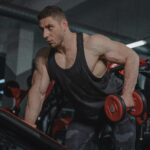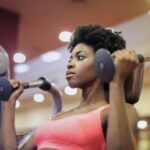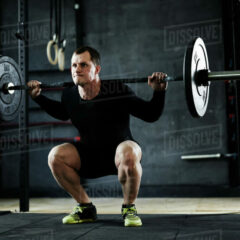https://weightliftingforpower.com/understanding-the-key-components-of-arms-for-power-programs/
Understanding the Key Components of Arms for power programs serve as a foundational element in the broader sphere of strength training. Their purpose and importance lie in building muscle strength that enhances overall physical performance. These programs aren’t merely about aesthetics; they’re vital for increasing functional strength, translating to better performance in various physical activities.

There’s often confusion between arms trained for powerlifting versus bodybuilding. While both disciplines involve working out the arms, their objectives diverge. Powerlifting focuses on maximizing strength for heavy lifts, often prioritizing exercises that build endurance and raw power. On the other hand, bodybuilding leans more toward sculpting the muscles for symmetry and definition, though strength gains are a part of the process.
The arm muscles, primarily the biceps and triceps, play a significant role in generating the strength necessary for power exercises. They function in isolation and as part of a larger kinetic chain. When trained effectively, they contribute to improved performance in exercises like bench presses, rows, and even compound movements involving larger muscle groups.
Recognizing the function of arm muscles within these programs helps tailor workouts that yield results. Understanding their role in different kinds of lifts and exercises ensures a balanced approach to training, preventing overuse injuries while enhancing muscle development. The goal is to create synergy between muscle groups, boosting overall power capabilities.
Key Muscle Groups: Unlocking the Secrets of Arm Anatomy
Exploring the anatomy of arm muscles offers insight into how they contribute to overall strength. Understanding the primary components—the biceps, triceps, and brachioradialis—is crucial for targeting them effectively in power programs.

The biceps are found at the front of the upper arm and are essential for elbow flexion. Exercises like curls are vital for building strength and definition, and they’re often the focus for those seeking both strength and aesthetic development. The biceps involve many pulling actions, which are integral for exercises like chin-ups and rows.
The triceps make up the upper arm’s backside and are essential for pressing movements. They’re heavily utilized in exercises such as bench and overhead presses, where extending the arm against resistance builds power. Strong triceps contribute significantly to pushing strength, making them vital in powerlifting routines.
The often-overlooked brachioradialis, running along the forearm, assists in flexing the elbow and stabilizing movements. Though it may not stand out aesthetically like the biceps or triceps, it ensures balance and helps prevent injuries by supporting the arms during compound movements.
Understanding these muscles allows for a strategic approach to training, focusing on balanced development and avoiding common pitfalls like muscle imbalances. Rounding out the arm’s muscle strength ensures stability and power, key elements of any effective power training regimen.
Addressing common issues like tendonitis or imbalance can improve performance and comfort in workouts. Focusing on mechanics and biomechanics ensures these muscles aren’t just strong and resilient under pressure. Developing expertise in how these groups work together harmonizes movement and boosts performance.
Foundational Training Techniques: Building Strength and Power
Building powerful arms isn’t just about lifting the heaviest weights. It’s a blend of technique, consistency, and innovative training. Curls, extensions, and presses form the backbone of practical arm training. Each exercise targets different areas of the arms, contributing to size and strength.
Proper form is crucial. With exercises like curls, it’s easy to let momentum take over, diminishing results. Keeping movements controlled ensures the muscles do the work, not the swing. Extensions and presses should focus on the full range of motion, maximizing each rep’s impact on muscle fibers.
To achieve significant gains in strength, embracing the principle of progressive overload is crucial in your training regimen. By gradually increasing the weight or resistance, you can effectively challenge your muscles, leading to greater growth and enhanced strength. Embrace the progress and transform your physical power! Small, incremental changes lead to substantial gains over time, reducing the risk of injury that can come with rapid increases.
Mixing up the routine keeps the muscles guessing and promotes growth. Incorporating different variations of curls—like hammer or preacher curls—can hit the muscles from various angles. Extension variations and presses also offer unique muscle stress, ensuring comprehensive development.
Training frequency matters, too. Striking a balance between pushing the muscles and allowing them to recover leads to better results. Arms, though resilient, benefit from rest just like any other muscle group. So, space out arm workouts to allow recovery while keeping a consistent routine.
Optimizing Performance: Expert Tips and Strategies
Recovery and nutrition play pivotal roles in maximizing arm strength. Sufficient rest enables muscles to recover and develop, while good nutrition supplies the essential energy for that development. Consuming enough protein and staying hydrated are crucial steps for anyone serious about developing powerful arms.
Advanced training methods can add a new dimension to arm workouts. Techniques like supersets, where two exercises are performed consecutively without rest, keep the intensity high. Drop sets, reducing weights mid-set, help push muscles past their usual limits. Isometric holds enhance endurance, focusing on maintaining muscle tension even without movement.
Keeping motivation high and avoiding common pitfalls ensures steady progress. Many people rush through reps or neglect muscle groups like the brachioradialis, leading to imbalances. Focusing on consistent, well-rounded workouts prevents these issues.
Injury prevention is crucial for long-term success. Listening to your body, recognizing signs of fatigue, and adapting workouts accordingly minimizes harm. Incorporating movements that enhance flexibility and joint stability supports sustainable progress.
When implemented, these strategies lead to improved performance and more robust development. Focusing on balance, adapting workouts prudently, and embracing a holistic view of training naturally leads to stronger arms.
